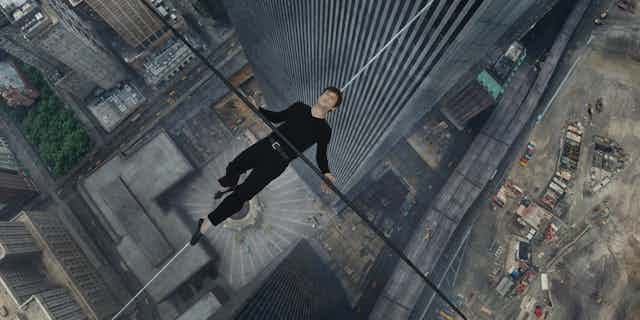The Program, out this weekend, dramatises Lance Armstrong’s meteoric fall from cycling grace after an investigation named him the leader of “the most sophisticated, professionalized and successful doping program that sport has ever seen”. It’s a familiar story and also the subject of Alex Gibney’s 2009 documentary The Armstrong Lie. So why produce a fictionalised account?
The Walk, another film in cinemas at the moment, is a remake of a documentary. Director Robert Zemeckis (Forrest Gump, Cast Away) has turned the story of French street artist Philippe Petit, who in 1974 managed to walk on a high wire between the newly built World Trade Centre towers, into a fiction film. In 2008, this same tale had been the subject of the Oscar-winning documentary, Man on Wire.
Why would we want to watch a fictional version of a documentary – particularly, as is the case with both of these – an exceptionally produced and well received documentary? How can a dramatisation compete with the depiction of life itself?

This isn’t a new issue. The dichotomy between fiction and reality has existed since the beginning of cinema itself. The “actualities” exhibited by the Lumiere brothers in Paris at the end of the 19th century were filmed with varying degrees of staging and artifice. Initially audiences marvelled at the moving images and were especially enraptured by the minutiae of everyday life captured by the camera, such as the wind rustling the leaves of trees. But patrons soon began craving the extraordinary, or at least, films with more developed stories. As a result, out of this “real” cinema sprang the “cinema of narrative” which, over the coming decades, became the industry standard.
Since then, what became known as documentary has struggled to compete with big-budget mainstream fiction films at the box-office. However, the two opposing film forms have borrowed techniques over the decades such that if a fiction film wanted to appear more realistic it might adopt a handheld camera aesthetic and if a documentary sought to be more “entertaining” it might include reconstructions.
This is where the comparison between Man on Wire and The Walk becomes interesting. James Marsh’s documentary already employed large helpings of fictionalised material, albeit derived from Petit’s own testimony. Consisting of talking head interviews, Man on Wire is punctuated by staged reconstructions of Petit and his accomplices sneaking into the Trade Centre under the cover of darkness. The film’s soundtrack and the grainy, black and white aesthetic create the impression of a heist movie akin to The Italian Job.
The Walk is pitched at a similar tone. Petit (played by Joseph Gordon-Levitt) is seen recruiting members to his gang and infiltrates the towers wearing a colourful array of disguises, wisecracking away. At some points, the script seems to lift verbatim from the documentary. So why make it?

One could argue that the success of the documentary reveals a readymade audience for the feature film. And those who may not have seen the documentary can witness a spectacle in 3D and IMAX. It also acts as a tribute to the Twin Towers. The Walk is able to do away with French subtitles, which might have kept some audiences from Man on Wire, by having Petit keep asking his accomplices to speak in English so that they might fit in when they travel to New York.
Promotional interviews indicate that the main reason for making the film was due to the fact that no footage exists of the event. Man on Wire includes photographs taken from the ground and on top of the towers, but does not show Petit completing his walk. So The Walk fills in a gap in the story.
The same is true of The Program. This film – directed by Stephen Frears from a screenplay by John Hodge – takes audiences behind the scenes to witness Armstrong’s doping. As such, it establishes a unique selling point when compared to documentary The Armstrong Lie, even though the latter features Armstrong himself. Imitation and impersonation are also draws to these films. As spectators, we are curious to see how accurate Gordon-Levitt as Petit and Ben Foster as Armstrong pay dues to their historical counterparts.
But whether one feels that recreating Petit’s unique, dangerous feat through CGI effects can come close to what it must have been like, or whether the atmosphere behind the doping scandal can be recreated, is beside the point. These fictional versions of documentaries are simply an alternative way of telling the same story. The boundary between fiction and nonfiction is becoming increasingly blurred.

